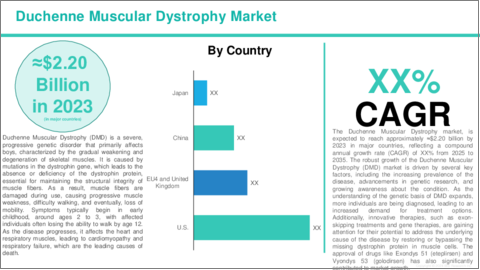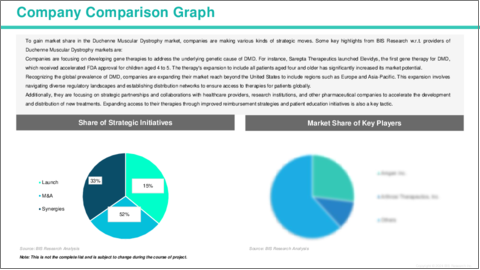|
|
市場調査レポート
商品コード
1759274
デュシェンヌ型筋ジストロフィー市場- 世界および地域別 - 分析と予測(2025年~2035年)Duchenne Muscular Dystrophy Market - A Global and Regional Analysis: Focus on Country and Region - Analysis and Forecast, 2025-2035 |
||||||
カスタマイズ可能
|
|||||||
| デュシェンヌ型筋ジストロフィー市場- 世界および地域別 - 分析と予測(2025年~2035年) |
|
出版日: 2025年06月30日
発行: BIS Research
ページ情報: 英文 100 Pages
納期: 1~5営業日
|
全表示
- 概要
- 図表
- 目次
デュシェンヌ型筋ジストロフィーは、主に男性が罹患し、進行性の筋力低下と変性を引き起こす遺伝性疾患です。
ジストロフィン遺伝子の変異によって引き起こされ、筋繊維の構造的完全性を維持する重要なタンパク質であるジストロフィンの欠失または重度の欠乏を引き起こします。ジストロフィンがない場合、筋細胞は正常に機能することができず、徐々に壊れていきます。その結果、小児期早期から筋力が低下し、青年期には運動能力を失うことが多いです。
デュシェンヌ型筋ジストロフィーは通常2~3歳の間に症状が現れ、歩行困難、頻繁な転倒、筋肉のけいれん、ガワー徴候(手や腕を使って床から立ち上がる方法)などが一般的な徴候です。進行すると骨格筋だけでなく心筋や呼吸筋にも影響を及ぼし、心臓障害や呼吸困難を引き起こします。この疾患は寿命を著しく縮め、呼吸器や心臓の合併症のために10代後半から20代前半で亡くなる人が多いです。
デュシェンヌ型筋ジストロフィー市場の主な促進要因のひとつは、遺伝子変異、家族歴、母親の高年齢といった危険因子の有病率の上昇です。デュシェンヌ型筋ジストロフィーはX連鎖性劣性遺伝性疾患であり、主な危険因子はジストロフィン遺伝子の欠損の遺伝です。この疾患は保因者、特に母親から息子に遺伝することが多いため、家族歴が重要な役割を果たします。さらに、母親の年齢が高いほど、デュシェンヌ型筋ジストロフィーにつながる遺伝子変異の可能性が高くなります。これらの遺伝的要因に加え、遺伝子検査が利用しやすくなったことで、早期診断が可能になり、デュシェンヌ型筋ジストロフィーに対する認識が高まり、早期の介入が促されています。診断患者数の増加に伴い、遺伝子治療やエクソンスキッピング薬などの革新的な治療に対する需要は増加の一途をたどっており、デュシェンヌ型筋ジストロフィー市場の成長を牽引しています。これらの要因が相まって、高度な治療オプションと早期介入戦略の必要性が強調され、市場の拡大が加速しています。
デュシェンヌ型筋ジストロフィー市場の成長にもかかわらず、いくつかの課題がその進展を阻害し続けています。主な課題の一つは、新しい治療法、特に遺伝子治療やExondys 51やVyondys 53のようなエクソンスキッピング薬に伴う治療費の高さです。これらの先進的な治療は法外に高価であるため、多くの患者、特に中低所得地域や包括的な保険が適用されない患者にとって、治療へのアクセスが制限されます。さらに、デュシェンヌ型筋ジストロフィーは希少疾患であるため患者数が少なく、企業はしばしば、これらの治療法の研究開発・製造にかかる高額な費用を正当化するための課題に直面します。また、デュシェンヌ型筋ジストロフィーは遺伝的に多様な患者集団が罹患するため、すべての患者に有効な普遍的な治療法を開発することが難しく、臨床試験が複雑であるという課題もあります。さらに、新しい治療法の長期的な安全性と有効性はまだ評価中であり、重篤な副作用を伴わずに効果を持続させるためには、さらなる調査が必要です。これらの要因が相まって、デュシェンヌ型筋ジストロフィーの治療が進歩し続けているにもかかわらず、その普及を阻む障壁となっています。
世界のデュシェンヌ型筋ジストロフィー市場は競争が激しく、Sarepta Therapeutics、Pfizer Inc.、Wave Life Sciences、Solid Biosciences、Molecular Partnersなどの主要企業が技術革新と市場成長を牽引しています。これらの企業は、デュシェンヌ型筋ジストロフィーの根本的な遺伝的原因に対処するため、エクソンスキッピング治療、遺伝子治療、タンパク質置換治療などの画期的な治療法を開発する最前線にいます。例えば、Sarepta Therapeuticsは、エクソンスキッピング技術を利用してデュシェンヌ型筋ジストロフィー患者の筋機能を改善するExondys 51(エテプリルセン)とVyondys 53(ゴロジルセン)を開発しました。ファイザー社は、Vyndys 53やその他のデュシェンヌ型筋ジストロフィーの遺伝子変異を対象とした治療に積極的に取り組んでいます。Wave Life Sciencesは、遺伝子編集とエクソンスキッピング技術を用いた治療法の開発に注力しています。Solid Biosciences、Molecular Partnersも、筋細胞におけるジストロフィン産生の回復を目指した革新的な遺伝子治療薬で大きく貢献しています。これらの進歩は、デュシェンヌ型筋ジストロフィーの治療状況を大きく変え、患者のアンメットニーズに対応し、市場の大幅な成長を促進すると期待されています。
市場セグメンテーション
セグメンテーション1:地域別
- 北米
- 欧州
- アジア太平洋
世界のデュシェンヌ型筋ジストロフィー市場は、デュシェンヌ型筋ジストロフィーの治療・管理方法を再構築する新たな動向に後押しされ、大きな変革期を迎えています。最も顕著な動向のひとつは、CRISPR遺伝子編集やウイルスベクターベースの遺伝子導入システムといった革新的なアプローチを含む遺伝子治療の進歩であり、これらは疾患の原因となる根本的な遺伝子変異に対処することを目的としています。これらの治療法は、筋肉細胞内で欠損したジストロフィンタンパク質を回復させるための、長期的あるいは永続的な解決策の可能性を提供しています。もう一つの主な動向は、ジストロフィン遺伝子の欠陥エクソンをスキップして、短いとはいえ機能的なジストロフィンを生成することを可能にするエクソンスキッピング薬(Exondys 51やVyondys 53など)の開発です。
こうした進歩に加え、個別化医療への注目も高まっており、個々の患者の特定の遺伝子変異に合わせた治療が行われ、介入の精度と有効性が向上しています。また、新規治療法の承認プロセスを迅速化する規制当局の支援や希少疾病用医薬品の指定も、この市場に利益をもたらしています。遺伝子検査による早期診断が普及するにつれて、早期介入に対する需要が高まり、より良い転帰をもたらし、市場成長の原動力となっています。さらに、希少疾患の専門治療センターの設立により、専門家による治療や最新の治療オプションへの患者のアクセスが向上しています。これらの動向は、デュシェンヌ型筋ジストロフィー市場を拡大させるだけでなく、患者にとってより効果的で、個別化され、治癒の可能性のある治療法への希望をもたらしています。
当レポートでは、世界のデュシェンヌ型筋ジストロフィー市場について調査し、市場の概要とともに、地域別の動向、および市場に参入する企業のプロファイルなどを提供しています。
目次
エグゼクティブサマリー
第1章 世界のデュシェンヌ型筋ジストロフィー市場:業界展望
- イントロダクション
- 市場動向
- 規制の枠組み
- 疫学分析
- 臨床試験分析
- 市場力学
第2章 世界のデュシェンヌ型筋ジストロフィー市場(地域別)、2023年~2035年
- 北米
- 欧州
- アジア太平洋
第3章 世界のデュシェンヌ型筋ジストロフィー市場:競合情勢と企業プロファイル
- 主要戦略と開発
- 合併と買収
- 相乗効果のある活動
- 事業拡大と資金調達
- 製品の発売と承認
- その他の活動
- 企業プロファイル
- Sarepta Therapeutics
- Pfizer Inc.
- Wave Life Sciences
- Solid Biosciences
- Molecular Partners
- Dystrophin Gene Therapy Companies
第4章 調査手法
List of Figures
- Figure: Global Duchenne Muscular Dystrophy Market (by Region), $Billion, 2024 and 2035
- Figure: Global Duchenne Muscular Dystrophy Market Key Trends, Analysis
List of Tables
- Table: Global Duchenne Muscular Dystrophy Market Dynamics, Impact Analysis
- Table: Global Duchenne Muscular Dystrophy Market (by Region), $Billion, 2024-2035
Global Duchenne Muscular Dystrophy Market, Analysis and Forecast: 2025-2035
Duchenne Muscular Dystrophy is a genetic disorder that primarily affects males and causes progressive muscle weakness and degeneration. It is caused by mutations in the dystrophin gene, which leads to the absence or severe deficiency of dystrophin, a crucial protein responsible for maintaining the structural integrity of muscle fibers. Without dystrophin, muscle cells are unable to function properly and gradually break down. This results in a decline in muscle strength, starting in early childhood and often leading to loss of mobility by adolescence.
Duchenne Muscular Dystrophy typically presents symptoms between the ages of 2 and 3, with common signs including difficulty walking, frequent falls, muscle cramps, and the Gower's sign (a method of using hands and arms to rise from the floor). As the disease progresses, it affects not only the skeletal muscles but also the cardiac and respiratory muscles, leading to heart problems and breathing difficulties. The condition significantly shortens life expectancy, with many individuals passing away in their late teens or early twenties due to respiratory or cardiac complications.
One of the key drivers of the duchenne muscular dystrophy market is the rising prevalence of risk factors such as genetic mutations, family history, and advanced maternal age. Duchenne Muscular Dystrophy is an X-linked recessive genetic disorder, meaning that the primary risk factor is the inheritance of a defective dystrophin gene, which results in the absence or deficiency of dystrophin in muscle cells. Family history plays a crucial role, as the disease is often inherited from carriers, particularly mothers who pass the defective gene to their sons. Additionally, advanced maternal age has been associated with a higher likelihood of genetic mutations that can lead to Duchenne Muscular Dystrophy. Along with these genetic factors, the increasing availability of genetic testing has led to more early diagnoses and greater awareness of Duchenne Muscular Dystrophy, prompting earlier interventions. As the number of diagnosed individuals increases, the demand for innovative treatments, such as gene therapies and exon-skipping drugs, continues to rise, driving the growth of the Duchenne Muscular Dystrophy market. These factors combined are accelerating the market's expansion as they highlight the need for advanced therapeutic options and early intervention strategies.
Despite the growth of the Duchenne Muscular Dystrophy market, several challenges continue to hinder its progress. One of the primary challenges is the high cost of treatment associated with emerging therapies, particularly gene therapies and exon-skipping drugs like Exondys 51 and Vyondys 53. These advanced treatments can be prohibitively expensive, limiting accessibility for many patients, especially in low- and middle-income regions or for those without comprehensive insurance coverage. Additionally, the small patient population for Duchenne Muscular Dystrophy, being a rare disease, means that companies often face challenges in justifying the high cost of research, development, and production of these therapies. Another challenge is the complexity of clinical trials, as Duchenne Muscular Dystrophy affects a genetically diverse patient population, making it difficult to develop universal treatments that work for all patients. Furthermore, the long-term safety and efficacy of new therapies are still being evaluated, and more research is needed to ensure sustained benefits without serious side effects. These factors together create barriers to the widespread adoption of Duchenne Muscular Dystrophy treatments, even as advancements continue to be made.
The global Duchenne Muscular Dystrophy market is highly competitive, with several leading companies driving innovation and market growth such as Sarepta Therapeutics, Pfizer Inc., Wave Life Sciences, Solid Biosciences, and Molecular Partners. These companies are at the forefront of developing groundbreaking therapies, including exon-skipping treatments, gene therapies, and protein replacement therapies to address the underlying genetic causes of Duchenne Muscular Dystrophy. Sarepta Therapeutics, for instance, has pioneered Exondys 51 (eteplirsen) and Vyondys 53 (golodirsen), which utilize exon-skipping technology to improve muscle function in Duchenne Muscular Dystrophy patients. Pfizer Inc. is actively involved with Vyndys 53 and other treatments aimed at genetic mutations in Duchenne Muscular Dystrophy. Wave Life Sciences focuses on advancing therapies that use gene editing and exon-skipping technology. Solid Biosciences and Molecular Partners are also making significant contributions with innovative gene therapies aimed at restoring dystrophin production in muscle cells. These advancements are expected to significantly transform the Duchenne Muscular Dystrophy treatment landscape, addressing the unmet needs of patients and driving substantial market growth.
Market Segmentation:
Segmentation 1: by Region
- North America
- Europe
- Asia-Pacific
The global Duchenne Muscular Dystrophy market is undergoing significant transformation, fueled by emerging trends that are reshaping the way Duchenne Muscular Dystrophy is treated and managed. One of the most prominent trends is the advancement of gene therapies, including innovative approaches like CRISPR gene editing and viral vector-based gene delivery systems, which aim to address the underlying genetic mutations responsible for the disease. These therapies are offering the potential for long-term or even permanent solutions to restore the missing dystrophin protein in muscle cells. Another key trend is the development of exon-skipping drugs, such as Exondys 51 and Vyondys 53, that enable the skipping of faulty exons in the dystrophin gene, allowing to produce a functional, albeit shorter, form of dystrophin.
In addition to these advancements, there is a growing focus on personalized medicine, where treatments are tailored to the specific genetic mutations of individual patients, improving the precision and effectiveness of interventions. The market is also benefiting from regulatory support and orphan drug designations, which help expedite the approval process for new treatments. As early diagnosis through genetic testing becomes more widespread, there is increased demand for early intervention, leading to better outcomes and driving market growth. Furthermore, the establishment of specialized care centers for rare diseases is improving patient access to expert care and the latest treatment options. Together, these trends are not only expanding the Duchenne Muscular Dystrophy market but also offering hope for more effective, personalized, and potentially curative treatments for patients.
Table of Contents
Executive Summary
Scope and Definition
Market/Product Definition
Inclusion and Exclusion
Key Questions Answered
Analysis and Forecast Note
1. Global Duchenne Muscular Dystrophy Market: Industry Outlook
- 1.1 Introduction
- 1.2 Market Trends
- 1.3 Regulatory Framework
- 1.4 Epidemiology Analysis
- 1.5 Clinical Trial Analysis
- 1.6 Market Dynamics
- 1.6.1 Impact Analysis
- 1.6.2 Market Drivers
- 1.6.3 Market Challenges
- 1.6.4 Market Opportunities
2. Global Duchenne Muscular Dystrophy Market (Region), ($Billion), 2023-2035
- 2.1 North America
- 2.1.1 Key Findings
- 2.1.2 Market Dynamics
- 2.1.3 Market Sizing and Forecast
- 2.1.3.1 North America Duchenne Muscular Dystrophy Market, by Country
- 2.1.3.1.1 U.S.
- 2.1.3.1 North America Duchenne Muscular Dystrophy Market, by Country
- 2.2 Europe
- 2.2.1 Key Findings
- 2.2.2 Market Dynamics
- 2.2.3 Market Sizing and Forecast
- 2.2.3.1 Europe Duchenne Muscular Dystrophy Market, by Country
- 2.2.3.1.1 Germany
- 2.2.3.1.2 U.K.
- 2.2.3.1.3 France
- 2.2.3.1.4 Italy
- 2.2.3.1 Europe Duchenne Muscular Dystrophy Market, by Country
- 2.3 Asia Pacific
- 2.3.1 Key Findings
- 2.3.2 Market Dynamics
- 2.3.3 Market Sizing and Forecast
- 2.3.3.1 Asia Pacific Duchenne Muscular Dystrophy Market, by Country
- 2.3.3.1.1 China
- 2.3.3.1.2 Japan
- 2.3.3.1 Asia Pacific Duchenne Muscular Dystrophy Market, by Country
3. Global Duchenne Muscular Dystrophy Market: Competitive Landscape and Company Profiles
- 3.1 Key Strategies and Development
- 3.1.1 Mergers and Acquisitions
- 3.1.2 Synergistic Activities
- 3.1.3 Business Expansions and Funding
- 3.1.4 Product Launches and Approvals
- 3.1.5 Other Activities
- 3.2 Company Profiles
- 3.2.1 Sarepta Therapeutics
- 3.2.1.1 Overview
- 3.2.1.2 Top Products / Product Portfolio
- 3.2.1.3 Top Competitors
- 3.2.1.4 Target Customers/End-Users
- 3.2.1.5 Key Personnel
- 3.2.1.6 Analyst View
- 3.2.2 Pfizer Inc.
- 3.2.2.1 Overview
- 3.2.2.2 Top Products / Product Portfolio
- 3.2.2.3 Top Competitors
- 3.2.2.4 Target Customers/End-Users
- 3.2.2.5 Key Personnel
- 3.2.2.6 Analyst View
- 3.2.3 Wave Life Sciences
- 3.2.3.1 Overview
- 3.2.3.2 Top Products / Product Portfolio
- 3.2.3.3 Top Competitors
- 3.2.3.4 Target Customers/End-Users
- 3.2.3.5 Key Personnel
- 3.2.3.6 Analyst View
- 3.2.4 Solid Biosciences
- 3.2.4.1 Overview
- 3.2.4.2 Top Products / Product Portfolio
- 3.2.4.3 Top Competitors
- 3.2.4.4 Target Customers/End-Users
- 3.2.4.5 Key Personnel
- 3.2.4.6 Analyst View
- 3.2.5 Molecular Partners
- 3.2.5.1 Overview
- 3.2.5.2 Top Products / Product Portfolio
- 3.2.5.3 Top Competitors
- 3.2.5.4 Target Customers/End-Users
- 3.2.5.5 Key Personnel
- 3.2.5.6 Analyst View
- 3.2.6 Dystrophin Gene Therapy Companies
- 3.2.6.1 Overview
- 3.2.6.2 Top Products / Product Portfolio
- 3.2.6.3 Top Competitors
- 3.2.6.4 Target Customers/End-Users
- 3.2.6.5 Key Personnel
- 3.2.6.6 Analyst View
- 3.2.1 Sarepta Therapeutics






